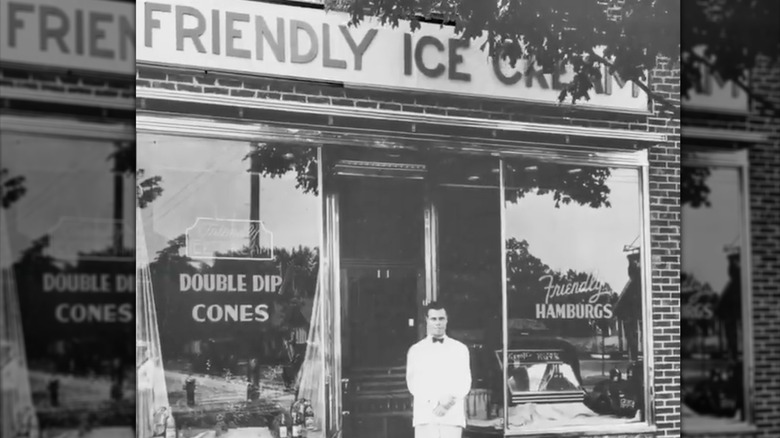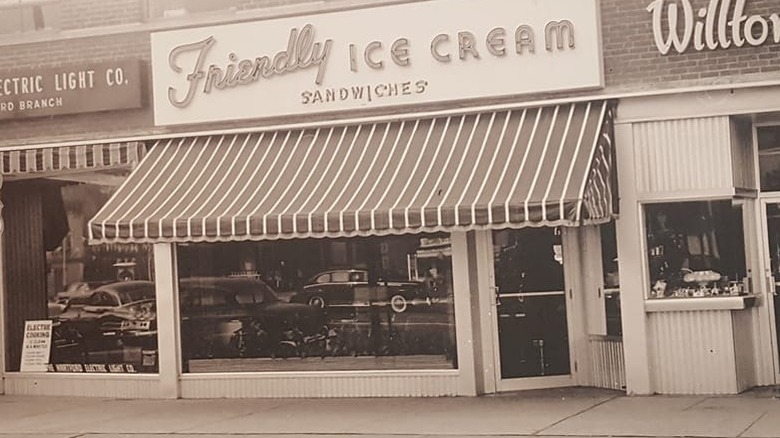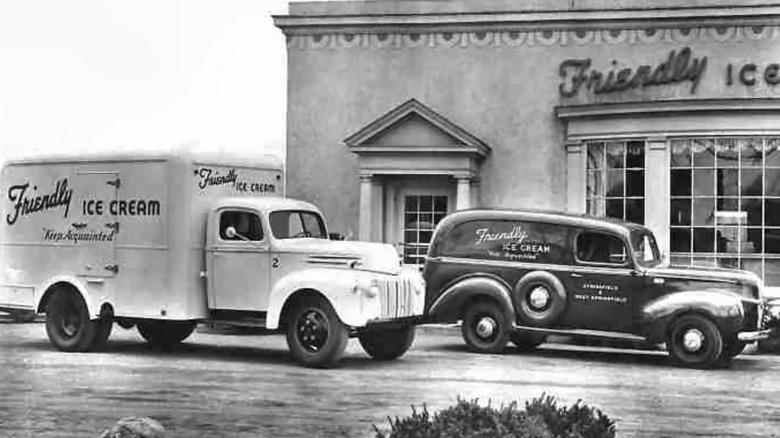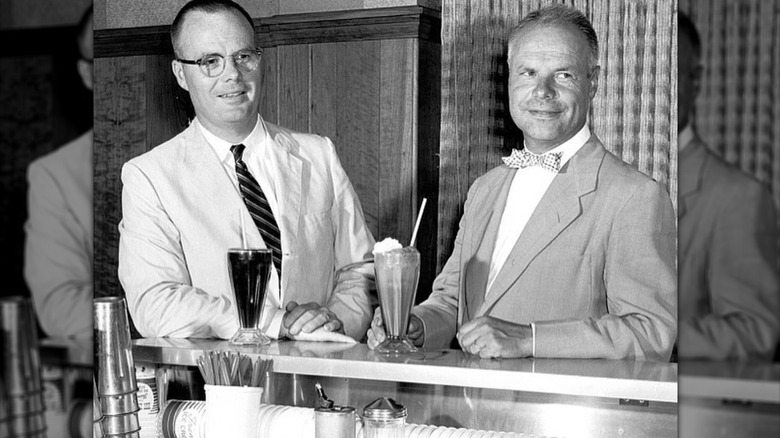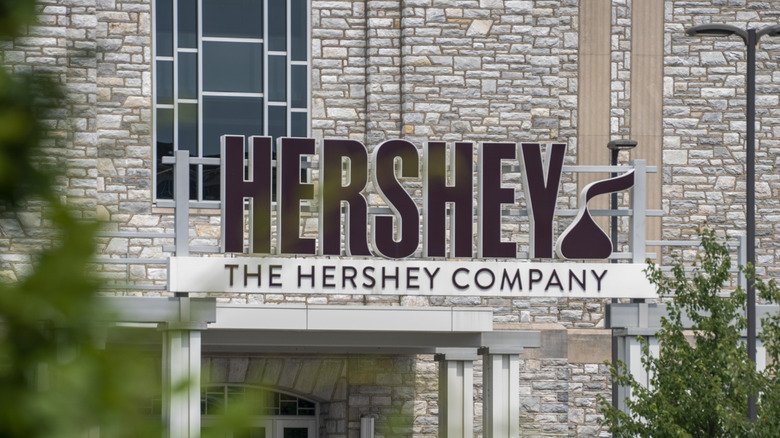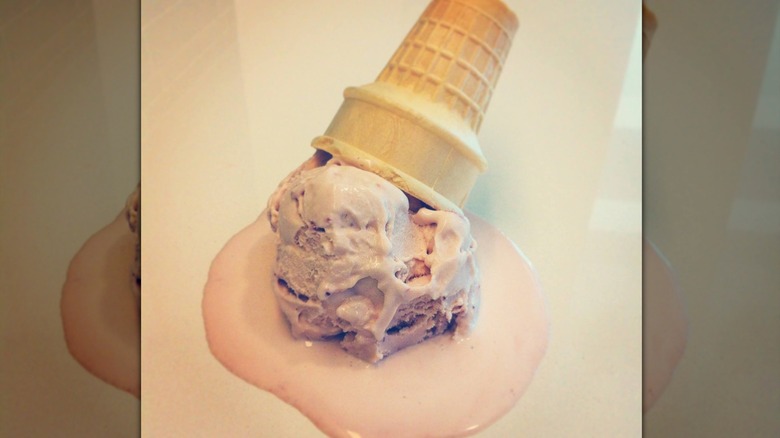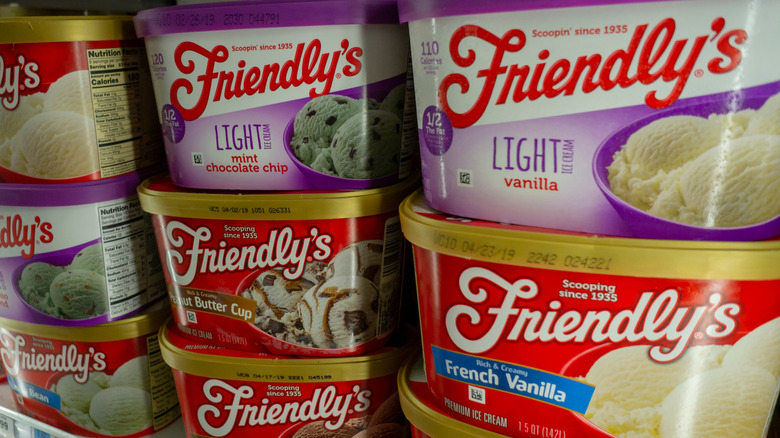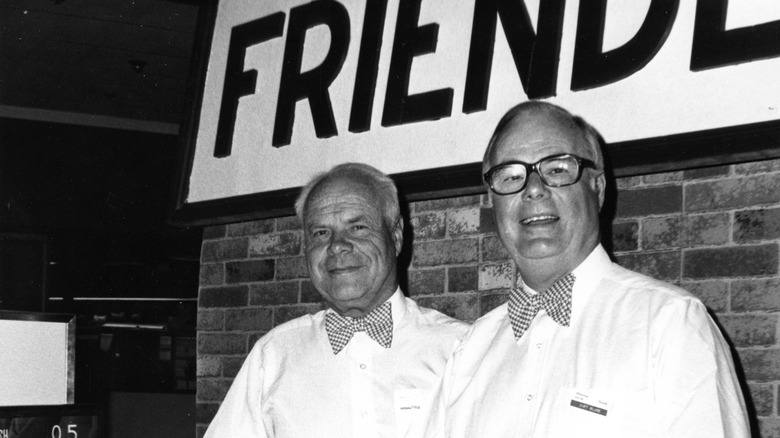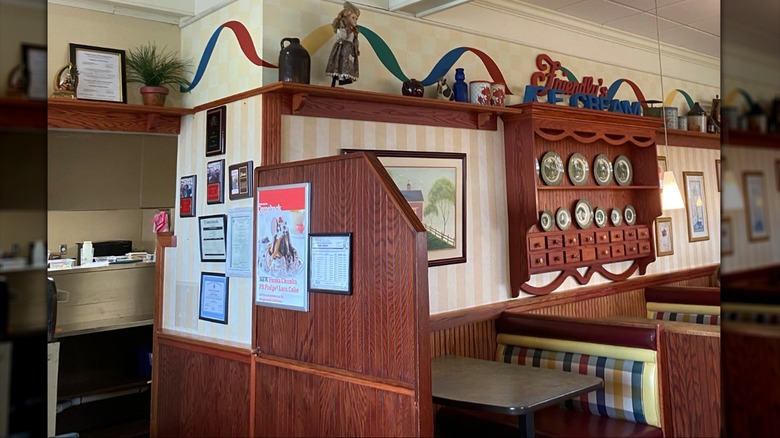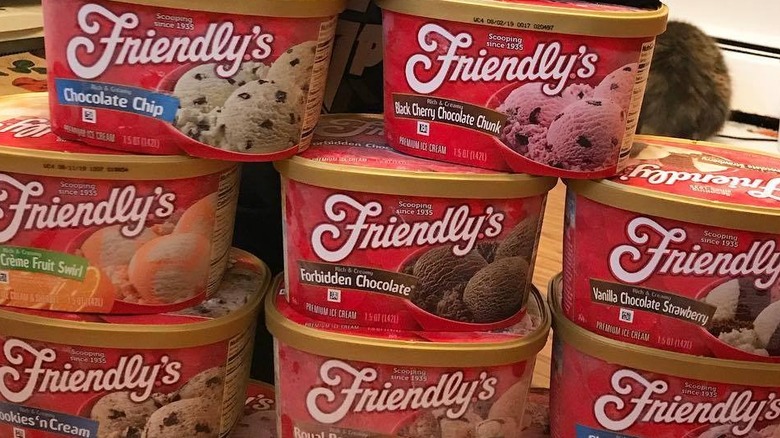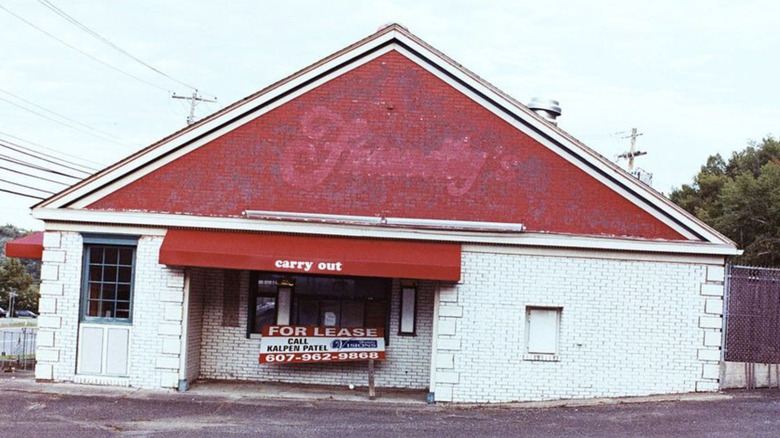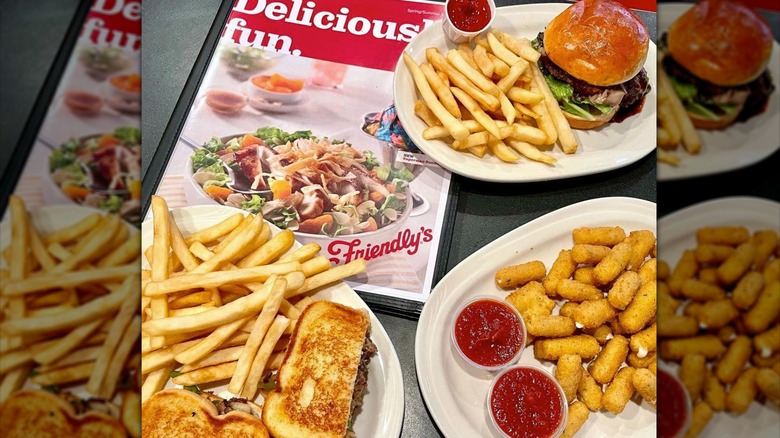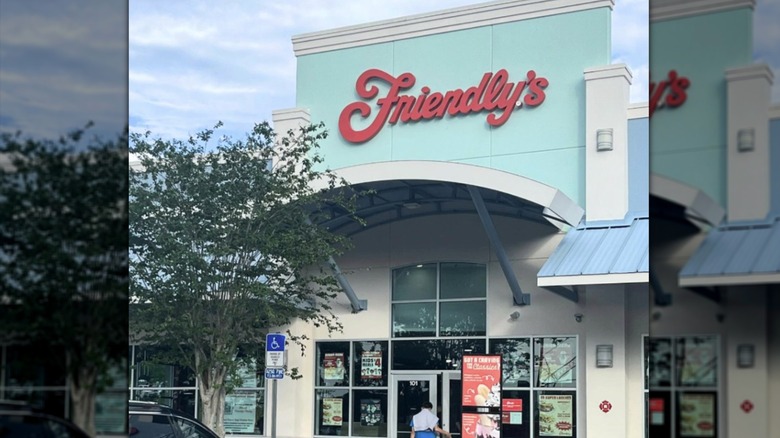The Rise And Fall And Resurgence Of Friendly's
If you're a Friendly's fan, chances are you associate the restaurant with fond memories from days gone by. Maybe it was the setting for Saturday morning breakfasts with grandma, where you grabbed an ice cream after dance class, or gossiped in a booth with your high school friends over coffee or whatever menu tidbits you could barely afford. For many of us East Coasters, seeing Friendly's slip into near obscurity wasn't easy to accept — almost as if the memories we associated with the place might fade away with it.
Let's not hold a premature funeral for Friendly's. The casual restaurant, best known for its ice cream, is still roughly 100 locations strong. At its height in the mid-1990s, over 850 Friendly's locations dotted the Eastern United States from coast to coast, so it's fair to say the regional chain has taken quite a blow. Looming bankruptcies and a string of fledgling CEOs are responsible for Friendly's shaky foothold — but so is the old-fashioned-ness of it all. Are fond recollections of the Friendly's fresher days enough to keep it alive today?
Possibly. Even as locations continue to go out of business, some franchisees are dedicated to expanding. Friendly's ice cream is still sold in grocery stores. The Jonas Brothers want Friendly's to survive. Here, we'll dig into Friendly's wholesome origins, its rise to greatness, and the resurgence of a true American classic.
Friendly's was family-oriented from the start
Before Friendly's became a suburban haunt, it was simply Friendly Ice Cream, founded by brothers Prestley and Curtis Blake in Springfield, Massachusetts in 1935. The Great Depression was still the nation's grim reality at the time, and the Blakes' mother feared the economic crisis would leave her sons jobless. With a $547 loan from their parents, 20-year-old Prestley and 18-year-old Curtis Blake opened their ice cream business.
They called it Friendly, so that customers would know that welcoming service accompanied the ice cream. The Blakes' business model was simple: one brother would make the ice cream while the other served customers. Neighboring drugstores and soda shops sold two scoops or a double-dip ice cream cone for a dime back then — the Blakes would sell the same items, but for a nickel. When Friendly Ice Cream opened its doors, on a summer evening in 1935, the line was about 100 feet long. They stayed open until midnight and sold 552 cones for a takeaway of $27.60.
Friendly Ice Cream quickly became a popular spot in Springfield. Despite his youth, Prestley Blake was a shrewd businessman who was all for efficiency and fiercely anti-debt. For the first five years, the Blake brothers shared a used 1928 Ford Model A and rarely took time off. When customers began suggesting that Friendly sell both food and ice cream, the Blakes listened.
A new location and a new menu arrived in 1940
With the original Springfield location turning a profit, Prestley and Curtis Blake opened a second Friendly Ice Cream in 1940 in West Springfield, Massachusetts. In tandem with the new location, the Blakes broadened Friendly Ice Cream's menu to include sandwiches — an idea that Friendly Ice Cream regulars had suggested to the Blakes.
At first, the sandwich selection was the epitome of simple. A hamburger served on toasted, sliced bread known as a Patty Melt (a diner food trend of the era), was one of the original Friendly sandwiches. A grilled cheese sandwich was also served, as many of Friendly Ice Cream's Catholic customers went meat-free on Fridays. The Patty Melt and grilled cheese are still on Friendly's menu today.
The addition of hot food to the Friendly Ice Cream repertoire was a decision that would eventually shift the establishment from quaint ice cream shop to sit-down restaurant. With two locations and more variety, Friendly Ice Cream was on track to become a profitable chain. Sandwiches were the most notable departure from Friendly Ice Cream's original brand image, but the 1940s menu expanded within its ice cream and beverage sections as well. Malted milkshakes, floats, bulk portions of takeaway ice cream, and even grape juice had a place at Friendly Ice Cream. The Blakes hard work was paying off, but a huge change was on the horizon for the business — and the country at large.
Business operations were put on hold during World War II
In 1943, two years after the United States entered World War II, Friendly Ice Cream closed up entirely. Wartime rations made sugar and cream scarce, so the Blakes decided to focus on the war effort. They posted a sign on the shops' windows saying Friendly Ice Cream would reopen when America won the war. In the meantime, Curtis Blake joined the military and Prestley Blake worked with Westinghouse Corp.
Friendly came back strong in 1945, with a renewed eagerness for expansion. In 1946, Friendly Ice Cream delivery trucks were introduced, making it more convenient than ever to enjoy the restaurant's ice cream. In America's post-war years, suburban neighborhoods were flourishing — especially in the Northeast, where Friendly was based. These lifestyle changes helped Friendly Ice Cream prosper.
Shopping plazas became more widespread, and erecting Friendly locations within them proved successful. The concept of a soup and sandwich lunch and an ice cream for dessert was well-suited to the cultural tastes of adults and children. Friendly was becoming the go-to casual family restaurant of suburbia. Between 1945 and 1952, the chain grew by two locations per year.
Friendly amassed 500 locations without franchising a single one
Friendly Ice Cream's immediate post-war success invigorated its founders to enact a robust expansion plan. In 1952, Friendly aimed to add five stores every year until 1954. One of Friendly's secrets to success was co-founders Curtis and Prestley Blake's ability to counterbalance their professional strengths. Curtis Blake planned and oversaw the building of every new Friendly location while Prestley Blake took the lead on the financial side. Both brothers were personally involved in the chain's rise to greatness. When the Blakes led Friedly, not a single location was franchised out ... and there were a lot of locations.
In the early 1950s, the Blakes opened a manufacturing plant in West Springfield, Massachusetts. All of the ice cream, syrups, sundae toppings, and sandwich ingredients used at Friendly Ice Cream establishments were processed at this facility. In 1960, Friendly Ice Cream's headquarters and the plant moved to Wilbraham, Massachusetts. Meanwhile, new Friendly locations were opening up and down the East Coast. By 1974, the chain had 500 units to its name and a second manufacturing plant in Troy, Ohio.
In 1979, Friendly sells to Hershey
After 44 years in the biz, the Blakes had more than earned a peaceful retirement. In that time, they literally built Friendly Ice Cream from the ground up, and in 1979 it was thriving — so much so that Hershey was interested in acquiring the company. Hershey, a titan of the sweets market and an actual American icon seemed like a worthy successor to all the Blakes had worked for. The brothers sold to Hershey to the tune of $162 million.
Prestley Blake was 65 when Friendly was sold, Curtis Blake was 63. By then, there were roughly 600 Friendly Ice Cream locations for Hershey to assume. The Blake brothers, who worked so seamlessly together as the company's co-founders were at fundamental odds for the first time. Prestley Blake looked back on the sale to Hershey's with regrets while Curtis felt comfortable passing the torch.
Hershey embraced the new ownership. Its legendary candies became standard fare in Friendly sundaes, something fans of the chain have come to count on. Hershey's capital helped the restaurant to grow at a quicker pace than ever, the new owners also took to renovating some of the older Friendly locations. It was an auspicious new chapter, despite smacking of the corporate impersonal business dealings that were in direct conflict with Friendly's core values.
Friendly's success dwindled in the late 80s
Hershey didn't have ill intentions with its acquisition of Friendly Ice Cream. In fact, under new ownership, Friendly continued to expand its reaches as a family-oriented chain. Yet Friendly didn't prosper under a big name banner long-term. Cracks began to show, perhaps for the first time, in Friendly's business operations.
New Friendly locations continued to open, however, in the late 1980s, profits fell for the first time in the restaurant's history. In 1988, Hershey shed Friendly's like a dead skin — claiming that ownership of the restaurant chain detracted from the brand's focus on the sweets and snacks segment. Friendly was sold to Tennessee Restaurant Co. (TRC) for approximately $375 million.
TRC quickly made changes. The restaurant name was changed to "Friendly's" and it was just the beginning of some serious streamlining. Over 100 Friendly's locations were slated for closure because they were struggling to turn a profit. The majority of these locations were in Florida, Ohio, and Virginia. Business operations were still going strong in Friendly's home base of New England ... for the time being.
Friendly's finds a sweet spot in the grocery store
Under TRC's ownership, Friendly's new owner was Donald N. Smith, a businessman whose expertise was reviving tired restaurant chains. Smith understood that Friendly's early capitalization on prepackaged ice cream — which was a smooth operation thanks to the manufacturing plant Friendly's had been running since the 1950s — was helping the chain stand out. Hershey tested the waters of putting more Friendly Ice Cream novelties in grocery stores, but Smith wanted to sell Friendly's ice cream in thousands of supermarkets. In 1989, that's exactly what Friendly's did.
The full-scale launch into the frozen food aisle included more than just half gallons of Friendly's ice cream. Pre-made sundaes, ice cream cakes, and inventive treats like the Jubilee Roll, a holiday item Friendly's developed in the 1970s, were featured prominently in grocery store freezers all over the East Coast. Friendly's was also able to effectively keep up with frozen treat trends. As consumer demand for lower fat ice cream and frozen yogurt grew, Friendly produced and sold those items. Even as the restaurant itself waned in popularity, Friendly's ice cream has remained a reliable retail item for the brand.
Financial problems lurked before the Great Recession ... and brought Friendly's co-founder out of retirement
Under the leadership of CEO Donald N. Smith, Friendly's made some rebranding attempts, but customers literally weren't buying it. In 1992, Consumer Reports placed Friendly's last amongst 14 family restaurant chains, noting that customers who were surveyed expressed disappointment in Friendly's food quality, dining atmosphere, and service. In response, restaurants continued to open, existing ones were renovated, and upscale menu additions like steak, roasted chicken, and baked fish were introduced. Profits slowly ticked up — but so did the company's debt.
In 1997, Friendly's went public on the stock market, a move TRC hoped would ease the mounting debt. Friendly's also began franchising in 1998. Co-founder Prestley Blake had been keeping tabs on Friendly's from a distance, and was seething with anger over how Smith and TRC were running the venture he still referred to as "his baby".
Though he was in his late 80s, Blake bought $2 million in Friendly's stock and became the company's largest shareholder. He then sued Smith, claiming that his flagrant personal use of the corporate jet and considerable stake in another restaurant company were against the best interests of Friendly's shareholders. A bitter legal battle was waged over the course of several years, ultimately forcing TRC to sell. Sun Capital purchased Friendly's in 2007 for $337.2 million. It got Smith out of the picture, but would lead to even bigger financial issues for the restaurant.
Friendly's struggled to modernize in a changing world
When Sun Capital affiliate Freeze Operations Holding Corp. acquired Friendly's in 2007, it appointed John Maguire as the new CEO, and took the company private to deal with Friendly's way too public financial dramas. Maguire quickly realized that Friendly's staunchly retro stance in the new millennium was a huge part of the company's now woeful image. Cluttered restaurant menus, outdated dining rooms, and fierce competition in the fast casual market had brought Friendly's to its knees. Maguire and Freeze Operations Holding Corp. decided it was time to start closing more units and selling off Friendly's real estate.
Though steeped in decline, Friendly's still rolled out new menu efforts that were more of the times — such as a 555 calories or under meal selection for $7.99 in early 2011 — but any marketing attempts in the name of modernity were often undercut by customers having to eat in restaurant dining rooms that were unignorably run-down. In October 2011, Friendly's filed for Chapter 11 Bankruptcy. A total of 424 restaurants stayed open while the company worked through financial restructuring. When Friendly's announced the news, it mostly blamed the recession and the rising cost of cream.
In 2016, Friendly's sold its ice cream to another company
A key factor in Friendly's slow and steady growth in the mid-20th century was its co-founders' insistence that Friendly's produced and owned all aspects of the business — from the restaurant buildings, to the plants that manufactured the ice cream, to the ice cream itself. When Friendly's sold its ice cream to dairy manufacturer Dean Foods in 2016, it truly felt like the end of an era. Dean Foods, based in Dallas, Texas, was the largest dairy processor in the U.S. at the time of the sale. The company purchased all of Friendly's manufacturing and retail operations for $155 million in cash.
When Dean Foods took over, Friendly's ice cream sales were up 105% — not too shabby for a company that filed for Chapter 11 Bankruptcy just five years earlier. Dean Foods agreed to operate out of Friendly's existing ice cream manufacturing facilities and retain the employees who worked there. By offloading the ice cream's manufacturing and retail duties to Dean Foods, Friendly's could continue to focus on continuing to improve its restaurants. About 100 units closed during the bankruptcy, leaving Friendly's with 254 locations as of September 2016.
Bankruptcy was a legitimate concern (again) during COVID
Friendly's financial well-being had been shaky for decades when COVID-19 wreaked irreparable havoc on the global restaurant industry. The chain did its best to grapple its way through pandemic-era restrictions, but in November 2020, it filed for Chapter 11 Bankruptcy for a second time. Friendly's was down to 130 restaurants at the time of the filing, but assured that nearly all of them would remain open while the company got back on its feet. Between 2020 and 2022, Friendly's closed 23 locations.
Worsening the situation was the depressing deal Friendly's made to be acquired by Amici Partners Group LLC, an affiliate of Brix Holdings for just $2 million. The low price was to account for Friendly's huge debts. Lenders were willing to waive $88 million in secured debt in order to close the deal in January 2021.
Friendly's co-founder Prestley Blake, (who with his brother Curtis sold Friendly's for $164 million in 1979), would probably have been rolling in his grave at the news — if he were in a grave that is. Blake lived to see the company he built from $547 and a Depression-era dream plunge into such sad proceedings. He turned 106 that November, and passed away months later, in February 2021. Curtis Blake was spared the news — he died in 2019 at age 102.
New ownership meant a new shot at revival
With Friendly's future on the ropes, new owners Brix Holdings planned for yet another brand refresh. Come 2022, the plan was to play upon Friendly's legacy as a classic American eatery while sprucing up the menu with foods that would appeal to a younger crowd. That meant shrinking Friendly's new menu from eight pages to two, tossing out tired items and introducing playful picks like the $100,000 Cobb Salad, the Doritos Cool Ranch Chopped Cheese Burger, and new ice cream flavors. A rewards program was launched and company-wide events like a Fribble giveaway on Founders Day, was a surefire way to draw the crowds.
Some of the new foods came off as gimmicky, but at least Friendly's was trying to keep it current. It even tapped The Jonas Brothers to each design their own limited-edition Friendly's sundaes in honor of the trio's 2023 world tour. In April 2024, Friendly's announced that a new Late Night Value Menu would be offered in all of its restaurants, giving the chain a fighting chance to compete in the after-hours fast food market.
This is what Friendly's looks like today
It's been a bumpy ride for Friendly's, but if the recent past is any indicator of how the future will go, resurgence is in the air. Yes, there were more closures in 2024 which hit the Northeast — once home to Friendly's steadiest customer base. Yet as one Friendly's door closes, another opens — this time in Florida, where fresh approaches are keeping hope alive.
A new Friendly's that opened in Orlando, Florida (it's one of two Friendly's in the city), features a more open ice cream counter, complete with a Fribble wall where kids can customize milkshakes to their hearts' content. Sundae toppings are displayed in clear jars instead of hidden away like they were in Friendly's ice cream window days. Friendly's current CEO Sherif Mityas is optimistic that the more interactive space will breathe new life into the 89-year-old brand.
Friendly's is still leaning into gimmicky menu items, like an ice cream sundae surrounded by a wreath of french fries (Mityas maintains it did well in the testing market). But the menu hasn't been totally overrun by fads. Overall, Friendly's is more mindful about growing slowly but surely — a business practice the company's founders perfected all those decades ago. Just over 100 Friendly's stores remain in business. About 20% have undergone a recent remodel, with the remaining locations expected to get their renovations over the next year. Profitably, not merely expansion is the primary objective for Friendly's moving forward.

